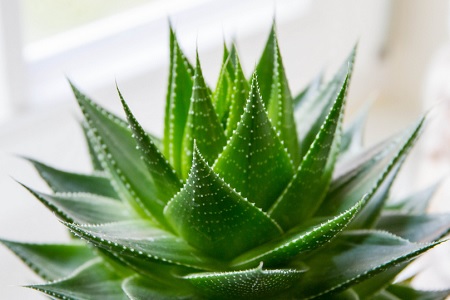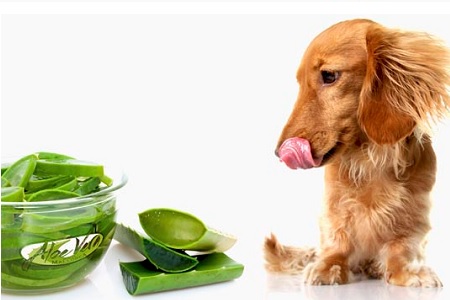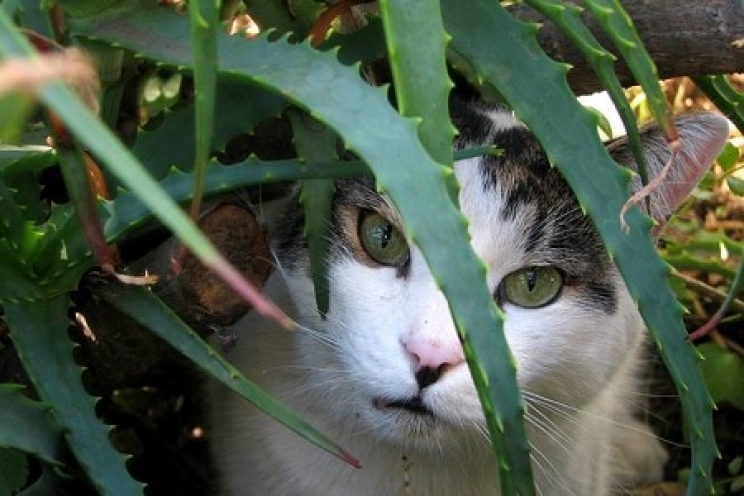Now a days on TV, in newspapers and on the web there is more and more talking about aloe Vera products, whose properties would be truly excellent for the health of the whole organism. Do you know that the extracts and the juice of this miraculous plant can also be used in the veterinary field for the care of our animals? Here are the beneficial properties of aloe Vera and how it is used in dogs and cats.
What is Aloe Vera?
Aloe Vera is the common name used in reference to Aloe bardensis, a fleshy plant of the Liliaceae family, made up of long, rigid and pointed leaves, which are characterized by the presence of an abundant gelatinous substance, from which we get an excellent juice. This aspect is due to the great ability of the aloe to withstand long periods of dryness, since each leaf is made up of an intricate system of vesicles rich in liquid, essential for ensuring nutrients to the plant even in the absence of water in the soil.
The leaves have a thick outer coating, rich in spikes along the lateral edges. This coating, called the cuticle, contains substances belonging to anthraquinones, including aloin, known above all for its laxative effects and for its very bitter taste.

By cutting the cuticle, a rather dense gel comes out immediately, rich in very important sugars, called mucopolysaccharides, such as glucomannans and acemannan, which have immunostimulating, anti-inflammatory and healing properties. The gelatinous substance also contains many vitamins, especially A, B, C, E, but also mineral salts, amino acids, plant hormones, enzymes.
The origins of this plant are to be placed in the subequatorial areas, in particular in Africa and in the Middle Eastern countries. It is no coincidence, in fact, that the first historical sources relating to the cultivation of aloe date back to 2000 BC, according to what has been ascertained by some findings dated at this time near the current Baghdad.
Even the ancient Egyptians used aloe to embalm the dead and we find traces of this tradition even in the Bible, where it is written that the bandages to be applied on the body of Christ were impregnated with aloe and myrrh.
The word "aloe", in fact, derives from the Hebrew term "allal", but also from the Arabic "alloch", indicating in both cases the definition of bitter, precisely because the juice of the plant is bitter.
Despite being widely used in the past, its importance has been underestimated for many years, until the 1950s, when Texas pharmacist Bill Coats managed to prevent the rapid deterioration of aloe gel thanks to a series of stabilization processes. Thanks to this discovery, aloe managed to save a large number of people from the very dangerous effects of burns, for which this plant is truly excellent. For this reason, the American government recognized in the same period the effectiveness of aloe Vera in treating burns, as an official remedy.
The first traces of the use of aloe in the veterinary field date back to the 70s, when Dr. Robert Northway conducted research on dogs, cats and horses suffering from mycosis and treated them with aloe Vera gel. Out of 71 animals, 67 managed to heal with aloe Vera cutaneous administration.
Over the years, the experiment has also been expanded to treat many other diseases, especially for problems in the muscles, tendons and joints of horses.
The properties of Aloe Vera
According to some theories, to obtain the maximum benefits from aloe Vera, every component of the leaf should be used. In reality, due to the bitter taste and the laxative properties of the external cuticle, it is preferred to use only the gel or the juice, equally capable of bringing beneficial effects.
Among the most interesting and proven properties of aloe Vera we find:
- Immunostimulant: the acemannan present in the aloe gel manages to enhance the functioning of the immune system, protecting against infections;
- Healing: glucomannans are able to accelerate the regeneration process of the skin in case of wounds, burns, cuts, fissures, rashes and burns;
- Anti-inflammatory and painkillers: according to some research, aloe would have very similar effects to those of cortisone, reducing inflammation and even pain;
- Disinfectant: aloin and fatty acids present in the plant are able to contrast infections by bacteria, viruses and fungi;
- Detoxifying: it helps the liver and kidneys to eliminate all the toxins that are produced every day by our body or that are introduced from the outside, such as drugs;
- Antitumor: Eventhough it has not yet been ascertained yet, according to some researchers, aloe Vera may even help cure tumors.
All these properties work together, enhancing the effects of aloe for a large number of uses, both in the human and veterinary fields.
What problems can it be used for?
In the veterinary field, aloe Vera gel or pure plant juice can be indicated in case of:
- Dermatitis
- Injuries
- Mycosis of the skin
- Feline acne
- Gingivitis
- Otitis
- Halitosis
- Cystitis
- Prostatitis
- Constipation
- Insect bites
- Liver problems
- Kidney problems
- ulcers
Many veterinarians recommend aloe Vera-based remedies also in case of joint problems, such as hip or elbow dysplasia and can be spreaded on the affected part.

The main usage of this plant is certainly the skin one, in gel form. It is very important, to avoid buying products that are not pure, but mixed with other unclear substances, which may not be suitable for our animals. The only exception is represented by some remedies based on pure aloe Vera juice and other harmless plants for dogs and cats, such as American red blueberry or cranberry, exceptional for the well-being of the urinary tract.
Generally the pure aloe Vera juice can be dissolved without problems in the drinking water of our four-legged friend. One tablespoon per liter of water is sufficient, so a teaspoon can be enough in a medium-sized cat bowl.
If we prefer to use gel or juice as a syrup, the dose varies according to the size of the animal. For small cats and dogs, a teaspoon 2-3 times a day, for medium sized dogs a spoonfull, whilst for large sized dogs two spoonfulls, always 2-3 times a day.
The cream, however, can be applied with a light massage twice a day on the affected area. It is a product for external use, remember that dogs and cats, unlike us, continually lick their fur, so we rely on absolutely harmless solutions even in case of accidental ingestion.
Aloe Vera gel can also be used to treat the dog and cat gums by massaging them gently. Also excellent to apply as a normal toothpaste for animals.
When is it not indicated?
Aloe Vera is not always harmless to animals. In particular, we should avoid buying products that contain the external cuticle, which, as we said, has strong laxative effects, definitely useless if the animal does not suffer from severe constipation problems.
In addition to its laxative properties, aloin could also induce abortion in pregnant dogs and cats, so in these cases it is absolutely not recommended, as well as during breastfeeding.
In any case, to find out more about the indications and methods of taking aloe Vera, you can contact a veterinarian expert in homeopathy, who will surely be able to clarify any doubts.










